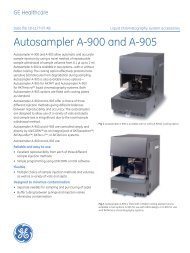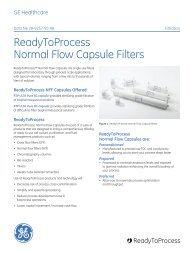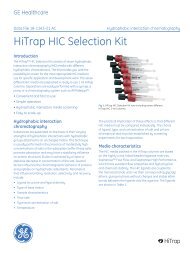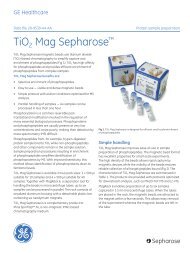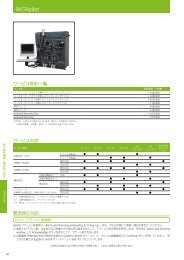Superdex High-performance Columns
Superdex High-performance Columns
Superdex High-performance Columns
You also want an ePaper? Increase the reach of your titles
YUMPU automatically turns print PDFs into web optimized ePapers that Google loves.
Table 1. The main characteristics of <strong>Superdex</strong> media<br />
<strong>Superdex</strong> Peptide <strong>Superdex</strong> 75 <strong>Superdex</strong> 200<br />
Separation range (M r) 100 to 7 000 (peptides) 3 000 to 70 000 (globular proteins) 10 000 to 600 000 (globular proteins)<br />
Exclusion limit (M r) 20 000 100 000 (globular proteins) 1 300 000 (globular proteins)<br />
pH stability 1 to 14 (long- and short-term) 3 to 12 (long-term),<br />
1 to 14 (short-term)<br />
3 to 12 (long-term),<br />
1 to 14 (short-term)<br />
Temperature stability 4°C to 40°C 4°C to 40°C 4°C to 40°C<br />
Working and storage<br />
temperature<br />
Matrix<br />
4°C to 30°C 4°C to 30°C 4°C to 30°C<br />
Spherical composite of crosslinked<br />
agarose and dextran<br />
Spherical composite of crosslinked<br />
agarose and dextran<br />
Average particle size 13 μm 13 μm 13 μm<br />
Spherical composite of crosslinked<br />
agarose and dextran<br />
Dextran<br />
Cross-linked agarose<br />
K av<br />
1.00<br />
<strong>Superdex</strong> Peptide<br />
0.75<br />
<strong>Superdex</strong> 75<br />
<strong>Superdex</strong> 200<br />
Fig 2. Schematic view through a section of a bead of <strong>Superdex</strong>. The average<br />
particle size is 13 μm. The composite dextran/cross-linked agarose matrix<br />
gives steep selectivity and high stability.<br />
0.50<br />
<strong>High</strong> speed gel filtration<br />
<strong>Superdex</strong> is a composite medium with high chemical<br />
and physical stabilities. The rigid matrix withstands high<br />
pressures and allows high flow rates to be used, which<br />
will give short separation times with retained function and<br />
stability. Even shorter cycles times are made possible with<br />
<strong>Superdex</strong> 75 and 200 5/150 GL, with bed heights of 150 mm,<br />
a natural column choice for screening experiments.<br />
0.25<br />
10<br />
100<br />
1000<br />
10000<br />
100000<br />
1000000<br />
Log M r<br />
Simple scale-up<br />
Scale-up to industrial production is simple and predictable,<br />
as <strong>Superdex</strong> 30, 75, and 200 prep grade media (mean bead<br />
size 34 μm) have similar selectivities as <strong>Superdex</strong> Peptide,<br />
75 and 200, respectively. <strong>Superdex</strong> 30, 75, and 200 prep<br />
grade media are available prepacked in HiLoad 16/60 and<br />
HiLoad 26/60 columns.<br />
Figure 4 shows the scale-up of a concentrated mouse<br />
monoclonal IgG cell supernatant from a <strong>Superdex</strong> 200 high<strong>performance</strong><br />
column, 10 mm × 300 mm (i.d. × bed height)<br />
(Fig 4A) to HiLoad 16/60 <strong>Superdex</strong> 200 prep grade (Fig 4B).<br />
Sample volume was increased five-fold yet the separation<br />
was almost identical.<br />
Fig 3. Selectivity curves for <strong>Superdex</strong> Peptide, 75, and 200. The steep<br />
selectivity gives high-resolution separations in the molecular weight range<br />
of 100 to 600 000.<br />
Chemical stability<br />
<strong>Superdex</strong> Peptide<br />
<strong>Superdex</strong> Peptide has outstanding chemical stability and<br />
is stable in the pH range of 1 to 14. Polar organic solvents,<br />
such as 70% acetonitrile in water and methanol, and<br />
chaotropic agents such as 6 M guanidine hydrochloride<br />
or 8 M urea can also be used. The high pH stability<br />
allows separation of very hydrophobic peptides in 70%<br />
formic acid, as well as use of alkaline buffers. Exposure<br />
to repeated 48-h cycles of 1.0 M NaOH, 0.1 M HCl, 10%<br />
TFA, 70% acetonitrile, and 70% formic acid has no effect<br />
on selectivity. The recommended cleaning procedure,<br />
described in the instructions, includes the use of 0.5 M<br />
NaOH or 0.1 M HCl. Hydrophobic contaminants can be<br />
removed with 30–70% acetonitrile.<br />
<br />
Data file 18-1163-79 AD



![[PDF] マニュアル GradiFrac](https://img.yumpu.com/22037825/1/190x253/pdf-gradifrac.jpg?quality=85)
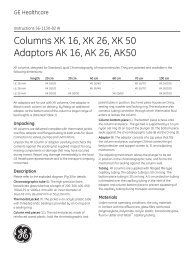
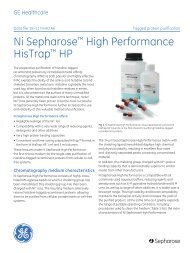
![[PDF] Sample preparation for analysis of protein, peptides and ...](https://img.yumpu.com/21549715/1/190x257/pdf-sample-preparation-for-analysis-of-protein-peptides-and-.jpg?quality=85)
![[PDF] Data File: rProtein A Sepharose Fast Flow](https://img.yumpu.com/21549316/1/190x253/pdf-data-file-rprotein-a-sepharose-fast-flow.jpg?quality=85)
![[PDF] MBP-tagged protein purification](https://img.yumpu.com/21548507/1/184x260/pdf-mbp-tagged-protein-purification.jpg?quality=85)
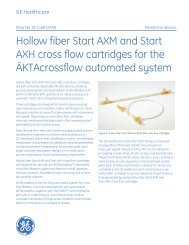
![[PDF] AKTA ready system Data file](https://img.yumpu.com/21540925/1/190x253/pdf-akta-ready-system-data-file.jpg?quality=85)
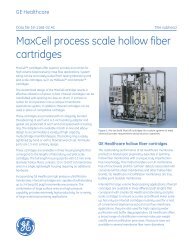
![[PDF] Data File - rProtein A/Protein G GraviTrap](https://img.yumpu.com/21539052/1/190x253/pdf-data-file-rprotein-a-protein-g-gravitrap.jpg?quality=85)
